How to find out the highest degree of oxidation. How to determine the degree of oxidation.
How to determine the degree of oxidation? The periodic table allows you to record a given quantitative value for any chemical element.
Definition
First, let's try to understand what this term is. The oxidation state according to the periodic table is the number of electrons that are accepted or given away by an element in the process of chemical interaction. It can take both negative and positive values.
Link to table
How is oxidation state determined? The periodic table consists of eight groups arranged vertically. Each of them has two subgroups: main and secondary. In order to set indicators for elements, certain rules must be used.

Instruction
How to calculate the oxidation states of elements? The table allows you to fully cope with a similar problem. Alkali metals, which are located in the first group (main subgroup), show the oxidation state in compounds, it corresponds to +, is equal to their highest valence. Metals of the second group (subgroup A) have +2 oxidation state.
The table allows you to determine this value not only for elements that exhibit metallic properties, but also for non-metals. Their maximum value will correspond to the highest valency. For example, for sulfur it will be +6, for nitrogen +5. How is their minimum (lowest) figure calculated? The table also answers this question. Subtract the group number from eight. For example, for oxygen it will be -2, for nitrogen -3.
For simple substances that did not enter into chemical interaction with other substances, the determined indicator is considered to be zero.
Let's try to identify the main actions related to the arrangement in binary compounds. How to put in them the degree of oxidation? The periodic table helps solve the problem.
For example, take calcium oxide CaO. For calcium located in the main subgroup of the second group, the value will be constant, equal to +2. For oxygen, which has non-metallic properties, this indicator will be a negative value, and it corresponds to -2. In order to check the correctness of the definition, we summarize the obtained numbers. As a result, we get zero, therefore, the calculations are correct.
Let us determine similar indicators in one more binary compound CuO. Since copper is located in a secondary subgroup (first group), therefore, the indicator under study may show different meanings. Therefore, to determine it, you must first identify the indicator for oxygen.
For a non-metal located at the end of a binary formula, the oxidation state has a negative value. Since this element is located in the sixth group, when subtracting six from eight, we get that the oxidation state of oxygen corresponds to -2. Since there are no indices in the compound, therefore, the oxidation state of copper will be positive, equal to +2.
How else is the chemical table used? The oxidation states of elements in formulas consisting of three elements are also calculated according to a certain algorithm. First, these indicators are placed at the first and last element. For the first, this indicator will have a positive value, correspond to valence. For the extreme element, which is a non-metal, this indicator has a negative value, it is determined as a difference (the group number is subtracted from eight). When calculating the oxidation state of the central element, a mathematical equation is used. The calculations take into account the indices available for each element. The sum of all oxidation states must be zero.

Example of determination in sulfuric acid
The formula of this compound is H 2 SO 4 . Hydrogen has an oxidation state of +1, oxygen has -2. To determine the oxidation state of sulfur, we compose a mathematical equation: + 1 * 2 + X + 4 * (-2) = 0. We get that the oxidation state of sulfur corresponds to +6.

Conclusion
When using the rules, you can arrange the coefficients in redox reactions. This issue is considered in the course of chemistry of the ninth grade of the school curriculum. In addition, information about the degrees of oxidation allows you to complete the tasks of the OGE and the Unified State Examination.
A chemical element in a compound, calculated from the assumption that all bonds are ionic.
The oxidation states can have a positive, negative or zero value, therefore the algebraic sum of the oxidation states of elements in a molecule, taking into account the number of their atoms, is 0, and in an ion - the charge of the ion.
1. The oxidation states of metals in compounds are always positive.
2. The highest oxidation state corresponds to the group number of the periodic system where this element is located (the exception is: Au+3(I group), Cu+2(II), from group VIII, the oxidation state +8 can only be in osmium Os and ruthenium Ru.
3. The oxidation states of non-metals depend on which atom it is connected to:
- if with a metal atom, then the oxidation state is negative;
- if with a non-metal atom, then the oxidation state can be both positive and negative. It depends on the electronegativity of the atoms of the elements.
4. Higher negative degree oxidation of non-metals can be determined by subtracting from 8 the number of the group in which this element is located, i.e. the highest positive oxidation state is equal to the number of electrons on the outer layer, which corresponds to the group number.
5. The oxidation states of simple substances are 0, regardless of whether it is a metal or a non-metal.
Elements with constant oxidation states.
|
Element |
Characteristic oxidation state |
Exceptions |
|
Metal hydrides: LIH-1 |
||
|
oxidation state called the conditional charge of the particle under the assumption that the bond is completely broken (has an ionic character). H- Cl = H + + Cl - , The bond in hydrochloric acid is covalent polar. The electron pair is more biased towards the atom Cl - , because it is more electronegative whole element. How to determine the degree of oxidation?Electronegativity is the ability of atoms to attract electrons from other elements. The oxidation state is indicated above the element: Br 2 0 , Na 0 , O +2 F 2 -1 ,K + Cl - etc. It can be negative and positive. The oxidation state of a simple substance (unbound, free state) is zero. The oxidation state of oxygen in most compounds is -2 (the exception is peroxides H 2 O 2, where it is -1 and compounds with fluorine - O +2 F 2 -1 , O 2 +1 F 2 -1 ). - Oxidation state a simple monatomic ion is equal to its charge: Na + , Ca +2 . Hydrogen in its compounds has an oxidation state of +1 (exceptions are hydrides - Na + H - and type connections C +4 H 4 -1 ). In metal-non-metal bonds, the atom that has the highest electronegativity has a negative oxidation state (electronegativity data are given on the Pauling scale): H + F - , Cu + Br - , Ca +2 (NO 3 ) - etc. Rules for determining the degree of oxidation in chemical compounds.Let's take a connection KMnO 4 , it is necessary to determine the oxidation state of the manganese atom. Reasoning:
K+MnXO 4 -2 Let X- unknown to us the degree of oxidation of manganese. The number of potassium atoms is 1, manganese - 1, oxygen - 4. It is proved that the molecule as a whole is electrically neutral, so its total charge must be equal to zero. 1*(+1) + 1*(X) + 4(-2) = 0, X = +7, Hence, the oxidation state of manganese in potassium permanganate = +7. Let's take another example of an oxide Fe2O3. It is necessary to determine the oxidation state of the iron atom. Reasoning:
2*(X) + 3*(-2) = 0, Conclusion: the oxidation state of iron in this oxide is +3. Examples. Determine the oxidation states of all atoms in the molecule. 1. K2Cr2O7. Oxidation state K+1, oxygen O -2. Given indexes: O=(-2)×7=(-14), K=(+1)×2=(+2). Because the algebraic sum of the oxidation states of elements in a molecule, taking into account the number of their atoms, is 0, then the number of positive oxidation states is equal to the number of negative ones. Oxidation states K+O=(-14)+(+2)=(-12). It follows from this that the number of positive powers of the chromium atom is 12, but there are 2 atoms in the molecule, which means that there are (+12):2=(+6) per atom. Answer: K 2 + Cr 2 +6 O 7 -2. 2.(AsO 4) 3-. IN this case the sum of the oxidation states will no longer be equal to zero, but to the charge of the ion, i.e. - 3. Let's make an equation: x+4×(- 2)= - 3 . Answer: (As +5 O 4 -2) 3-. |
Instruction
Take, for example, the substance formed by the reaction of gold with aqua regia, a mixture of three parts concentrated hydrochloric acid and one part concentrated nitric acid. The reaction proceeds according to the scheme: Au + 4HCl + HNO3 = H + NO + 2H2O.
As a result, a complex compound is formed - hydrogen tetrachloraurate. The complexing agent in it is a gold ion, the ligands are chlorine ions, and the outer sphere is a hydrogen ion. How to determine the degree oxidation elements in this complex connection?
First of all, determine which of the elements that make up the molecule is the most electronegative, that is, which will pull the total electron density towards itself. It is, of course, chlorine, since it is located in the upper right part of the periodic table, and in terms of electronegativity is second only to fluorine and oxygen. Therefore, his degree oxidation will be with a minus sign. What is the degree oxidation chlorine?
Chlorine, like all other halogens, is located in the 7th group of the periodic table, there are 7 electrons in its outer electronic level. By dragging another electron to this level, it will move to a stable position. Thus, his degree oxidation will be equal to -1. And since in this complex connection four chloride ions, then the total charge will be -4.
But the sum of the powers oxidation elements that make up the molecule must be equal to zero, because any molecule is electrically neutral. Thus, the negative charge of -4 must be balanced by the positive charge of +4, at the expense of hydrogen and gold.
Since hydrogen is the very first element of the periodic table and can give up only one electron to form a chemical bond, its degree oxidation equals +1. Accordingly, in order for the total charge of the molecule to be equal to zero, the gold ion must have degree oxidation+3. Problem solved.
There are charged particles - ions, their positive charge is equal to the number of electrons received from one atom of the element. The charge of an ion, considered negative, is equal to the number of electrons that one atom of a chemical element accepts. For example, the notation Ca2+ means that the atoms of the elements have lost one, two, or three electrons.
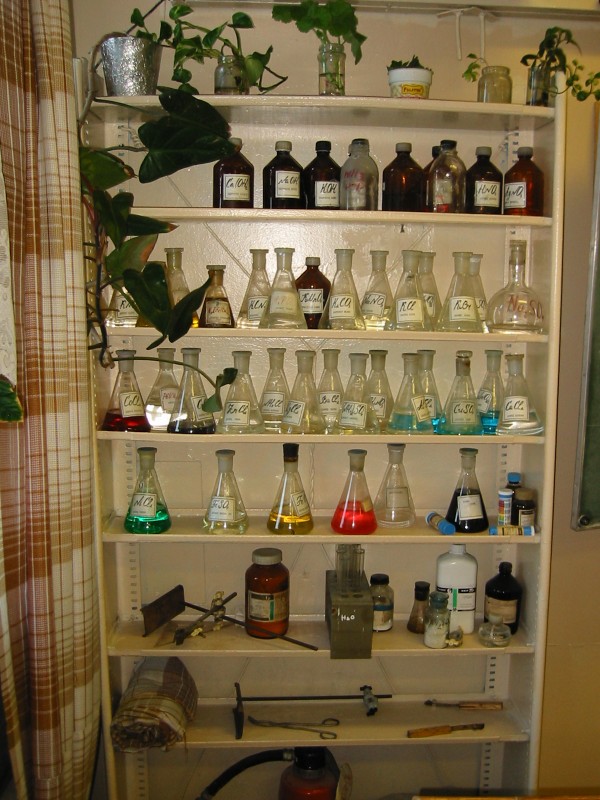
You will need
- A school textbook in chemistry for grades 8-9 of any author, the periodic table, a table of electronegativity of elements (printed in school textbooks in chemistry).
Instruction
To begin with, it is necessary to indicate that the degree oxidation- this is a conditional concept, taking connections as ionic, that is, not going deep into the structure. If the element is in a free state, then this is the simplest case - a simple substance is formed, which means that the degree oxidation its equal to zero. For example, hydrogen, oxygen, nitrogen, fluorine, etc.
In complex substances, everything is different: electrons are distributed unevenly between atoms, and it is the degree oxidation helps to determine the number of donated or received electrons. Degree oxidation may be positive or negative. With a plus, electrons are given away, with a minus they are received. Some elements of their degree oxidation are stored in various compounds, but many do not differ in this feature. It is necessary to remember an important rule - the sum of degrees oxidation is always zero. The simplest example, CO gas: knowing that the degree oxidation oxygen in the vast majority of cases is -2 and using the above rule, you can calculate the degree oxidation for carbon C. In sum with -2, zero gives only +2, which means the degree oxidation carbon +2. Let's complicate the problem and take CO2 gas for calculations: the degree oxidation oxygen still remains -2, but in this case there are two molecules of it. Therefore, (-2) * 2 = (-4). The number that adds up to -4 gives zero, +4, that is, in this gas carbon has a degree oxidation+4. A more complicated example: H2SO4 - hydrogen has a degree oxidation+1, oxygen has -2. In the given compound, there are 2 hydrogen molecules and 4 oxygen molecules, i.e. the charges will be, respectively, +2 and -8. In order to get a total of zero, you need to add 6 pluses. So the degree oxidation sulfur +6.
When it is difficult to determine in a compound where the plus is, where the minus is, an electronegativity table is needed (it is easy to find in a textbook on general chemistry). Metals often have a positive degree oxidation, while non-metals are negative. But for example, PI3 - both elements are non-metals. The table indicates that the electronegativity of iodine is 2.6, and that of phosphorus is 2.2. When compared, it turns out that 2.6 is greater than 2.2, that is, electrons are pulled towards iodine (iodine has a negative degree oxidation). Following the given simple examples, it is easy to determine the degree oxidation any element in the connections.
note
No need to confuse metals and non-metals, then the oxidation state will be easier to find and not get confused.
Degree oxidation called the conditional charge of an atom in a molecule. It is assumed that all bonds are ionic. In other words, the degree oxidation characterizes the ability of an element to form an ionic bond.

You will need
- - Mendeleev table.
Instruction
In a compound, the sum of the powers oxidation atoms is equal to the charge of this compound. This means that in a simple substance, for example, Na or H2, the degree oxidation element is zero.
In compounds with non-metals, the degree oxidation hydrogen is assumed to be equal to +1, in compounds with metals equal to -1. Example - in the CaH2 compound, calcium is a metal, degree oxidation hydrogen atoms is -1. Since the particle of matter is electrically neutral, the degree oxidation calcium should be equal to (0-(-1))*2 = +2. Indeed, the sum of the degrees oxidation calcium (+2) and two hydrogen atoms (-1) give zero. Similarly, HCl is a compound with the nonmetal chlorine. Degree oxidation hydrogen in this case is +1. Then the degree oxidation chlorine atom is -1.
Degree oxidation oxygen in compounds is usually -2. For example, H2O water has two hydrogen atoms and one oxygen atom. Indeed, -2+1+1 = 0 - on the left side of the expression is the sum of the powers oxidation all the atoms in the compound. In CaO, calcium has a degree oxidation+2, and oxygen - -2. Exceptions to this rule are OF2 and H2O2 compounds.
Fluorine has a degree oxidation is always -1.
Usually the maximum positive degree oxidation element matches the number of its group in Mendeleev's periodic table of elements. Maximum negative power oxidation equals the element group number minus eight. An example is chlorine in the seventh group. 7-8 = -1 - degree oxidation chlorine. The exception to this rule is fluorine, oxygen and iron - the highest degree oxidation below their group number. The elements of the copper subgroup have the highest degree oxidation more than 1.
Sources:
- The oxidation state of the elements
Degree oxidation element is the conditional charge of the atoms of a chemical element in a compound, calculated from the assumption that the compounds consist only of ions. They can have positive, negative, zero values. Metals have positive oxidation states, while non-metals can have both positive and negative oxidation states. It depends on which atom the nonmetal atom is connected to.

Instruction
When determining oxidation, it is necessary to know that the highest oxidation state of a metal corresponds to the group number of the periodic system where this element is located. But there are exceptions to this rule.
Also, the oxidation states of non-metals when combined with metal atoms are always negative, and when combined with non-metal atoms, they can be both negative and positive. The highest negative oxidation state of non-metals can be found by subtracting from 8 the number of the group in which the element is located. The highest positive is equal to the number of electrons on the outer layer (the number of electrons corresponds to the group number).
The oxidation state of a simple substance, regardless of whether it is a metal or a non-metal, is always zero. In molecules, the algebraic sum of these powers of elements, taking into account the number of their atoms, is equal to zero.
To easily determine the degree of any element in a compound, one must also remember that hydrogen has an oxidation state (+1) in compounds. Excluding hydrides (hydrogen compounds with metals of the main subgroup of the first and second groups, oxidation state -1, for example Na + H-); oxygen has (-2), except for the combination of oxygen with fluorine O + 2 F-2 and in peroxides (H2O2 - the oxidation state of oxygen (-1); fluorine has (-1).
For example, one should determine the oxidation states of elements in a molecule of potassium dichromate (potassium bichromate), the formula of which is K2Cr2O7. Two chemical elements potassium and oxygen, they are constant and equal to +1 and -2, respectively. The number of oxidation states for oxygen is (-2)•7=(-14), for potassium (+1)•2=(+2). The number of positives is equal to the number of negatives. Therefore (-14)+(+2)=(-12). This means that the chromium atom has 12 positive degrees, but there are 2 atoms, which means that there are (+12): 2 = (+6) per atom, write down the oxidation states of the elements: K + 12Cr + 6 2O-2 7.
Sources:
- determination of the degree of oxidation
Degree oxidation is the conditional charge of an atom in a compound, calculated on the assumption that it consists only of ions. Some elements have a constant degree oxidation while others can change it. To determine it for substances that have in different compounds, various meanings Let's use a special algorithm.
Part I
1. The oxidation state (s. o.) is conditional charge of the atoms of a chemical element in a complex substance, calculated on the basis of the assumption that it consists of simple ions.
Should know!
1) In connections with. O. hydrogen = +1, except for hydrides.
2) In compounds with. O. oxygen = -2, except for peroxides ![]() and fluorides
and fluorides
3) The oxidation state of metals is always positive.
For metals of the main subgroups of the first three groups With. O. constant:
Group IA metals - p. O. = +1,
Group IIA metals - p. O. = +2,
Group IIIA metals - p. O. = +3.
4) For free atoms and simple substances p. O. = 0.
5) Total s. O. all elements in the compound = 0.
2. Method of formation of names two-element (binary) compounds.

4. Complete the table "Names and formulas of binary compounds."

5. Determine the degree of oxidation of the highlighted element of the complex compound.
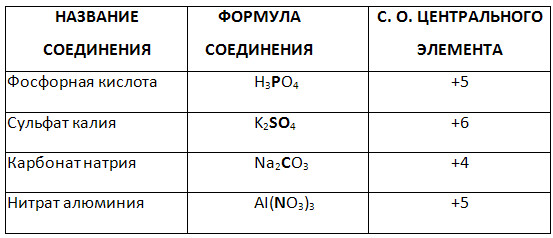
Part II
1. Determine the oxidation states of chemical elements in compounds according to their formulas. Write down the names of these substances.
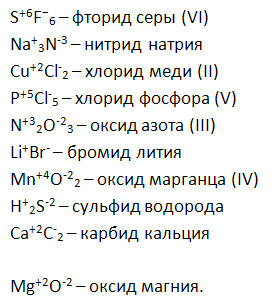
2. Separate substances FeO, Fe2O3, CaCl2, AlBr3, CuO, K2O, BaCl2, SO3into two groups. Write down the names of substances, indicating the degree of oxidation.

3. Establish a correspondence between the name and oxidation state of an atom of a chemical element and the formula of the compound.

4. Make formulas of substances by name.

5. How many molecules are contained in 48 g of sulfur oxide (IV)?

6. Using the Internet and other sources of information, prepare a report on the use of any binary connection according to the following plan:
1) formula;
2) name;
3) properties;
4) application.
H2O water, hydrogen oxide.
Water under normal conditions is a liquid, colorless, odorless, in a thick layer - blue. The boiling point is about 100⁰С. It is a good solvent. A water molecule consists of two hydrogen atoms and one oxygen atom, this is its qualitative and quantitative composition. This is a complex substance, it is characterized by the following Chemical properties: interaction with alkali metals, alkaline earth metals. Exchange reactions with water are called hydrolysis. These reactions have great importance in chemistry.
7. The oxidation state of manganese in the K2MnO4 compound is:
3) +6
8. Chromium has the lowest oxidation state in a compound whose formula is:
1) Cr2O3
9. Chlorine exhibits the maximum oxidation state in a compound whose formula is:
3) Сl2O7
Such a subject of the school curriculum as chemistry causes numerous difficulties for most modern schoolchildren, few people can determine the degree of oxidation in compounds. The greatest difficulties are for schoolchildren who study inorganic chemistry, that is, students of the basic school (grades 8-9). Misunderstanding of the subject leads to the emergence of hostility among students to this subject.
Teachers identify a number of reasons for such a “dislike” of middle and high school students for chemistry: unwillingness to understand complex chemical terms, inability to use algorithms to consider a specific process, problems with mathematical knowledge. The Ministry of Education of the Russian Federation has made serious changes to the content of the subject. In addition, the number of hours for teaching chemistry was "cut down". This had a negative impact on the quality of knowledge in the subject, a decrease in interest in the study of the discipline.
What topics of the chemistry course are the most difficult for schoolchildren?
According to the new program, the course of the discipline "Chemistry" of the basic school includes several serious topics: the periodic table of elements of D. I. Mendeleev, classes of inorganic substances, ion exchange. The most difficult thing for eighth graders is the definition of oxides.
Placement rules
First of all, students should know that oxides are complex two-element compounds that include oxygen. A prerequisite for a binary compound to belong to the class of oxides is the second position of oxygen in this compound.
Algorithm for Acid Oxides
To begin with, we note that the oxidation states are numerical expressions of the valency of the elements. formed by non-metals or metals with a valence of four to seven, the second in such oxides is necessarily oxygen.
In oxides, the valency of oxygen always corresponds to two; it can be determined from the periodic table of elements of D. I. Mendeleev. Such a typical non-metal as oxygen, being in the 6th group of the main subgroup of the periodic table, accepts two electrons in order to completely complete its external energy level. Non-metals in compounds with oxygen most often exhibit a higher valence, which corresponds to the number of the group itself. It is important to recall that the oxidation state of chemical elements is an indicator that implies a positive (negative) number.
The non-metal at the beginning of the formula has a positive oxidation state. Non-metal oxygen is stable in oxides, its index is -2. In order to check the reliability of the arrangement of values in acid oxides, you will have to multiply all the numbers you set by the indices of a particular element. Calculations are considered reliable if the total sum of all the pluses and minuses of the set degrees is 0.
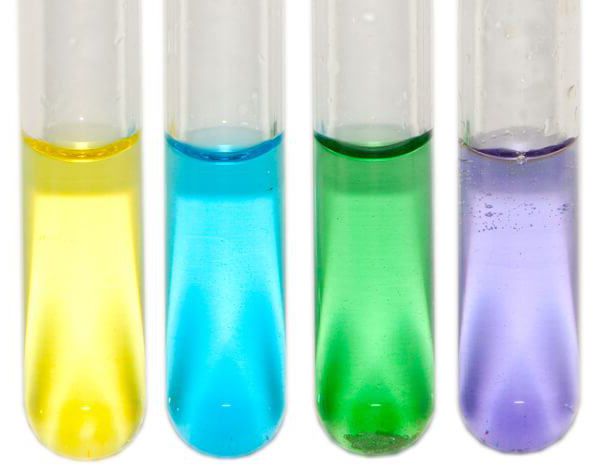
Compilation of two-element formulas
The oxidation state of the atoms of the elements gives a chance to create and record compounds from two elements. When creating a formula, for starters, both symbols are written side by side, be sure to put oxygen second. Above each of the recorded signs, the values \u200b\u200bof the oxidation states are prescribed, then between the numbers found is the number that will be divisible by both digits without any remainder. This indicator must be divided separately by the numerical value of the degree of oxidation, obtaining indices for the first and second components of the two-element substance. The highest oxidation state is numerically equal to the value of the highest valency of a typical non-metal, identical to the group number where the non-metal stands in PS.

Algorithm for setting numerical values in basic oxides
Oxides of typical metals are considered to be such compounds. They in all compounds have an oxidation state index of no more than +1 or +2. In order to understand what the oxidation state of a metal will be, you can use the periodic table. For metals of the main subgroups of the first group, this parameter is always constant, it is similar to the group number, that is, +1.
Metals of the main subgroup of the second group are also characterized by a stable oxidation state, numerically +2. The oxidation states of oxides, taking into account their indices (numbers), should add up to zero, since chemical molecule is considered to be a neutral, devoid of charge, particle.
Arrangement of oxidation states in oxygen-containing acids
Acids are complex substances, consisting of one or more hydrogen atoms, which are associated with some kind of acid residue. Given that oxidation states are numbers, some math skills are required to calculate them. Such an indicator for hydrogen (proton) in acids is always stable, it is +1. Next, you can specify the oxidation state for the negative oxygen ion, it is also stable, -2.
Only after these actions, it is possible to calculate the degree of oxidation of the central component of the formula. As a specific sample, consider the determination of the oxidation state of elements in sulfuric acid H2SO4. Given that the molecule of this complex substance contains two hydrogen protons, 4 oxygen atoms, we obtain an expression of this form +2+X-8=0. In order for the sum to form zero, sulfur will have an oxidation state of +6
Arrangement of oxidation states in salts
Salts are complex compounds consisting of metal ions and one or more acid residues. Method for determining the oxidation states of each of constituent parts in a complex salt is the same as in oxygen-containing acids. Given that the oxidation state of the elements is a numerical indicator, it is important to correctly indicate the oxidation state of the metal.
If the salt-forming metal is located in the main subgroup, its oxidation state will be stable, corresponds to the group number, is a positive value. If the salt contains a metal of a similar subgroup of PS, it is possible to show different metals by the acid residue. After the oxidation state of the metal is set, put (-2), then the oxidation state of the central element is calculated using the chemical equation.
As an example, consider the determination of the oxidation states of elements in (medium salt). NaNO3. The salt is formed by a metal of the main subgroup of group 1, therefore, the oxidation state of sodium will be +1. Oxygen in nitrates has an oxidation state of -2. To determine the numerical value of the degree of oxidation is the equation +1+X-6=0. Solving this equation, we get that X should be +5, this is

Basic terms in OVR
For the oxidative as well as the reduction process, there are special terms that students are required to learn.
The oxidation state of an atom is its direct ability to attach to itself (donate to others) electrons from some ions or atoms.
An oxidizing agent is considered to be neutral atoms or charged ions that acquire electrons during a chemical reaction.
The reducing agent will be uncharged atoms or charged ions, which in the process of chemical interaction lose their own electrons.
Oxidation is presented as a procedure for donating electrons.
Reduction is associated with the acceptance of additional electrons by an uncharged atom or ion.
The redox process is characterized by a reaction during which the oxidation state of an atom necessarily changes. This definition allows you to understand how you can determine whether the reaction is OVR.

OVR Parsing Rules
Using this algorithm, you can arrange the coefficients in any chemical reaction.
The last step will be the arrangement of the stereochemical coefficients in the reaction under consideration.
OVR example
First you need to arrange the oxidation states in each chemical substance. Note that the oxidation state is zero, since there is no return (attachment) of negative particles. The rules for the arrangement of oxidation states in binary and three-element substances were discussed by us above.
Then you need to determine those atoms or ions in which, during the transformation, the oxidation states have changed.
From the left side of the written equation, atoms or charged ions are isolated, which have changed their oxidation states. This is necessary for the balance sheet. Above the elements, their values must be indicated.
Further, those atoms or ions that were formed during the reaction are recorded, indicated by the + sign, the number of electrons accepted by the atom, - the number of negative particles given away. If, after the interaction process, the oxidation states decrease. This means that the electrons have been accepted by the atom (ion). With an increase in the degree of oxidation, an atom (ion) gives off electrons during the reaction.
Least total number divided first by the electrons received, then by the electrons given away in the process, the coefficients are obtained. The figures found will be the desired stereochemical coefficients.
Determine the oxidizing agent, reducing agent, processes occurring during the reaction.
Consider practical use of this algorithm on a specific chemical reaction.
Fe+CuSO4=Cu+FeSO4
We calculate the indicators for all simple and complex substances.
Since Fe and Cu are simple substances, their oxidation state is 0. In CuSO4, then Cu + 2, then oxygen has -2, and sulfur has +6. In FeSO4: Fe +2, therefore, for O-2, according to the calculations S +6.
Now we are looking for elements that could change the indicators, in our situation they will be Fe and Cu.
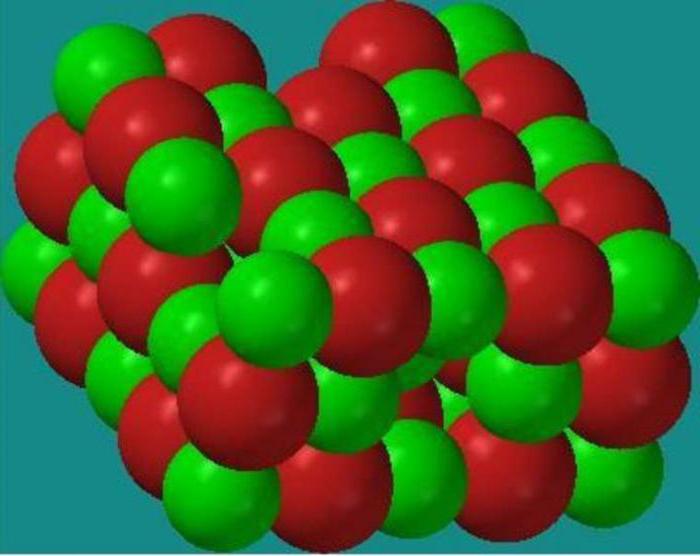
Since after the reaction the value of the iron atom became +2, 2 electrons were given up in the reaction. Copper has changed its indicators from +2 to 0, therefore, copper has accepted 2 electrons. Now we determine the number of received and given electrons by the iron atom and the divalent copper cation. During the transformation, two electrons were taken by the divalent copper cation, and the same number of electrons were given away by the iron atom.
In this process, it makes no sense to determine the minimum common multiple, since an equal number of electrons are received and given away during the transformation. The stereochemical coefficients will also correspond to unity. In the reaction, iron will show the properties of the reducing agent, while it is oxidized. The divalent copper cation is reduced to pure copper, in the reaction it has the highest oxidation state.

Application of processes
The oxidation state formulas should be known to every student in grades 8-9, since this question included in the tasks of the OGE. Any processes that proceed with oxidative, reducing signs play importance in our life. Without them, metabolic processes in the human body are impossible.



















